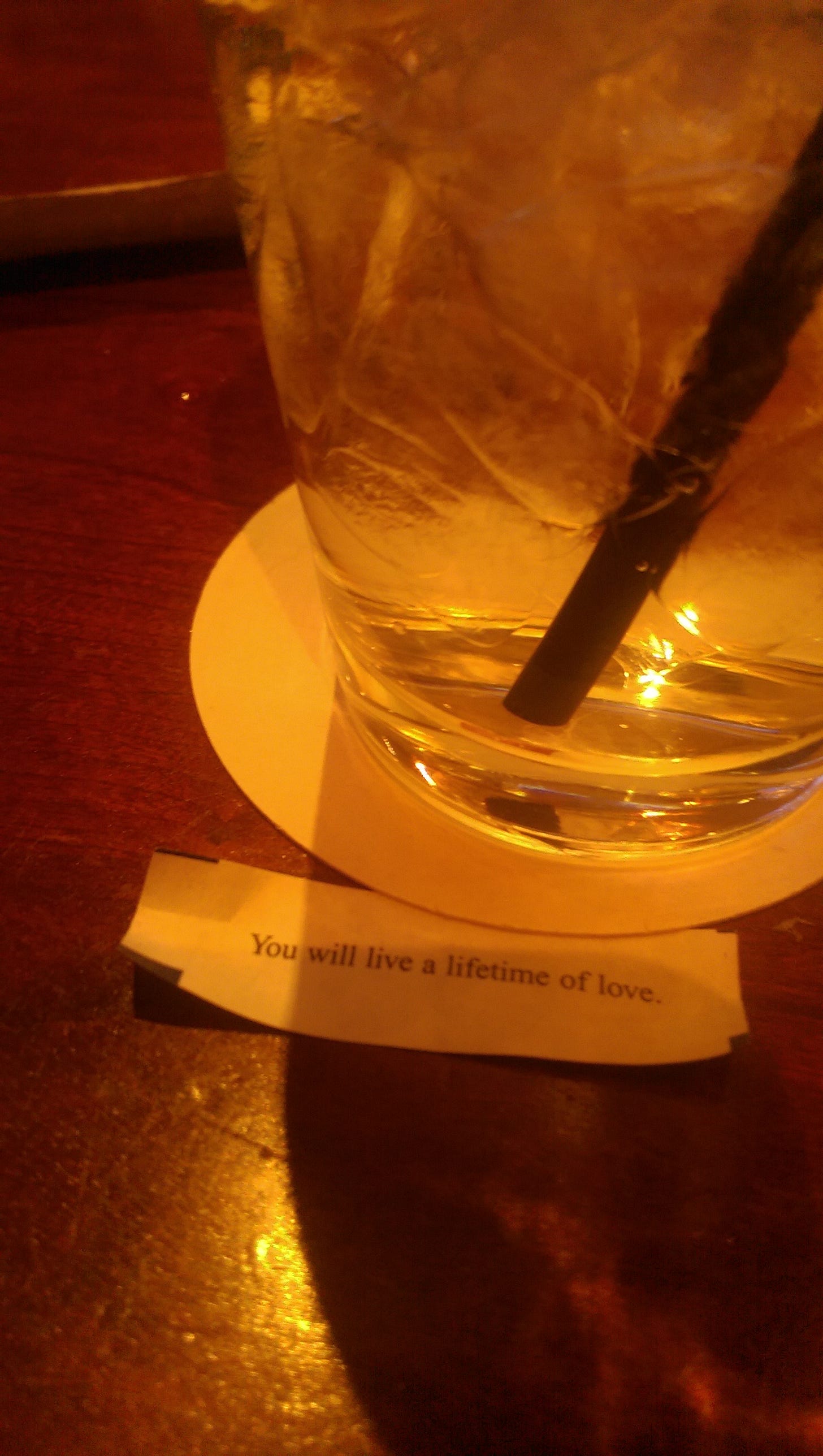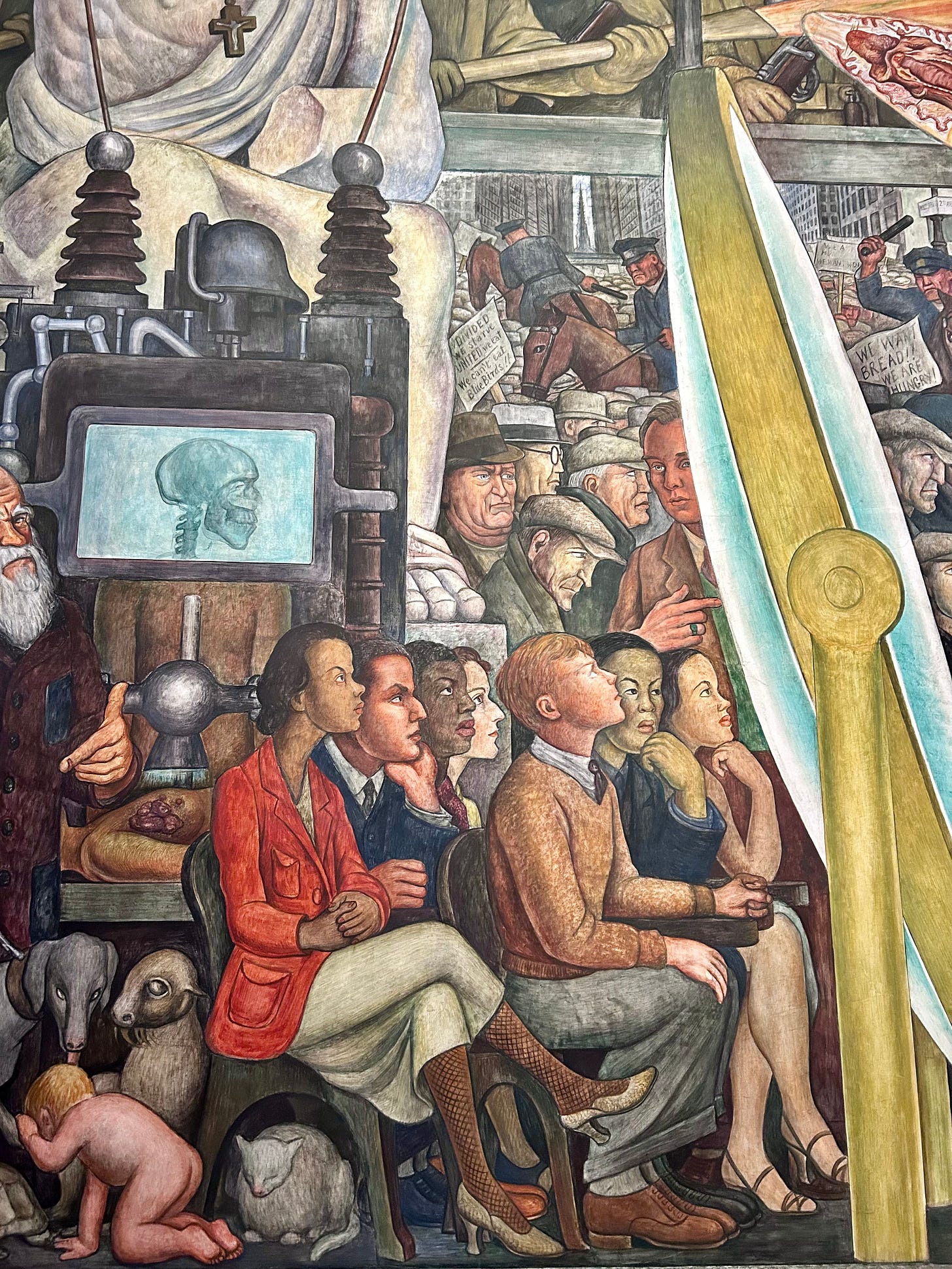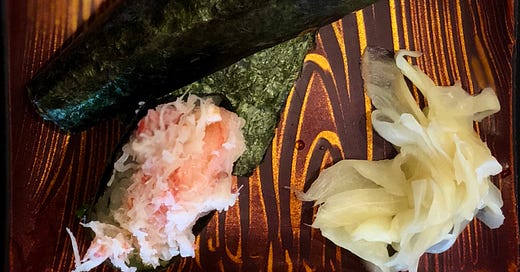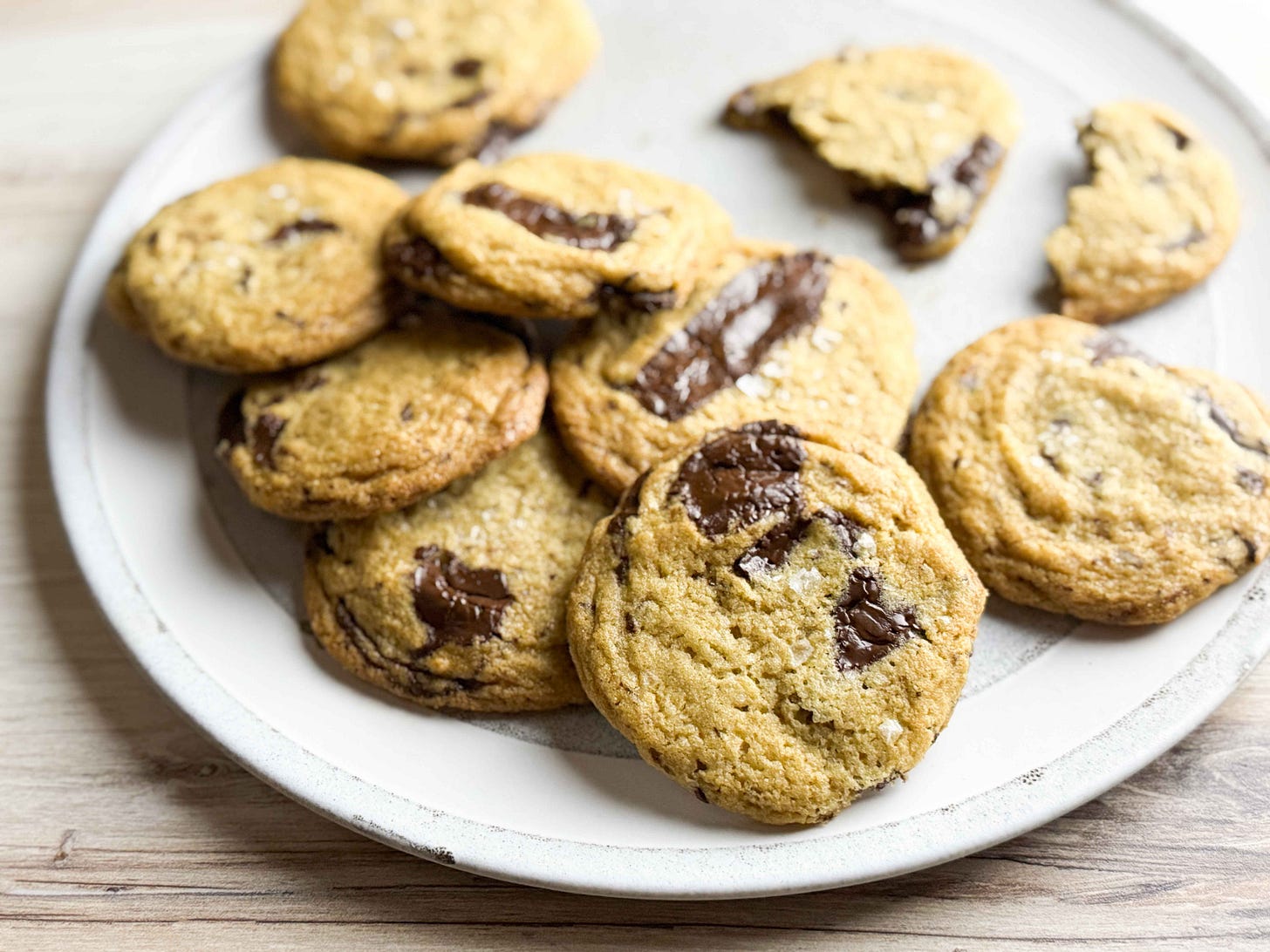**********************************************************************
First! Hello! At the end of this post, I’m going to introduce you to a James Beard Award-winning food writer, Leslie Brenner, whose Substack, Cooks Without Borders offers some of the best recipes and reflections on food culture you’ll find on the Internet.
I love listening to experts of any kind talk about their areas of expertise, so I love asking Leslie food questions. Over dinner recently, I asked her what I was doing wrong because when I cook fish in the oven, it tastes too fishy, but when I cook it in a pan, it’s mild, and without asking a single follow-up question, she said, “Nothing’s wrong. You just don’t like roasted fish.”
A revelation! I haven’t put fish in the oven since and I never will again.
Leslie is knowledgeable and fascinating when talking about anything food-related, whether it’s the fine points of a recipe or the nuances of chef gossip or the history of Amaro. She recently introduced my boyfriend and me (and in turn my whole family because my boyfriend and I dragged them there soon after) to the best Thai restaurant in Dallas. She runs a monthly cookbook club over Zoom that has gotten me out of my cooking comfort zone. If you don’t feel like reading my essay, scroll to the end of it and meet Leslie instead. And join the cookbook club! Then I’ll get to see you once a month.
**********************************************************************
TABLE FOR ONE
Recently, a woman told me that she feels judged when she eats alone in a restaurant. She said that she hears disdain in the hostess’s greeting: “Just you?” She said that even when the place is dead, she’s denied a booth. She said that the servers dismiss her and the other diners pity her.
This sounds crushing. And utterly foreign.
I frequently travel alone. I frequently eat in restaurants alone, preferably at the bar. I usually seek out sushi, even if I’m in, like, Nebraska. I love sushi. I love to eat sushi by myself at the sushi bar in Nebraska. (Actually, I don’t think I’ve been to Nebraska.)

There are three things I can’t consume responsibly: pistachios, chips and salsa, and sake. I have learned never to buy pistachios. Because I live in Texas, I’m frequently held hostage before complementary chips and salsa, watching my hand overthrow the regime of my free will. I try to make sake a special treat, but what is sushi without a nice, crisp sake? I love to eat sushi and drink sake, alone with my thoughts, preferably far from home, and then sleep in a hotel room.
When I was a child, the grownups called unmarried men “permanent bachelors.” I’ve never heard anyone in my generation say “permanent bachelor.” I’m proud of us for that. “Permanent bachelor” wasn’t as insulting as “old maid,” but it wasn’t generous, either. A permanent bachelor was “stuck in his ways.” To be stuck in one’s ways was egregious. I pictured the permanent bachelor, stuck in his ways, reading a newspaper on the toilet while struggling to shit.
Today, my sense of those permanent bachelors is that after many adult years un-partnered, they had the space and time and freedom to determine, This is how I like to live. Perhaps they didn’t care what others thought of their “ways.” Or they did care, because no human can resist the Siren song of caring, but they preferred to be stuck where they were (I mean, not on the toilet) than where others believed they should be.
It’s hard to be alone and it’s hard to be with people, but both are easy, too. You get the hang of things either way. Sometimes you feel incomplete and sometimes you observe an alternative and think, Thank god that’s not my life. If you have a bent toward envy, you’ll wish yourself into others’ existences. If you’re more curious than covetous, you’ll just as effortlessly emerge from the reverie, like turning the novel face-down on the table. (I never understood the precious insistence on bookmarks.)

Only one experience, ever, made me rethink eating alone.
I swear I sometimes eat food that’s not Asian, but this experience transpired in a Chinese restaurant while I was on assignment in Houston: The guy at the table next to mine began to choke.
Previously, I had only known human faces to exist in certain colors, but the diner inches away from me had a purple-blue face from an alien palette.
Years before I was born, while running on a beach, my dad gave life-saving mouth-to-mouth to a man who washed up on shore. I’ve thought about that scene a lot. I can picture it as though I was there, and every time, I tell myself: I need to learn CPR. That day in Houston, I had not learned CPR. (Today, I have also not learned CPR.)
The crowd in the Chinese restaurant, in the middle of the lunch rush, fell silent. That was eerie because it was inexplicable. The restaurant was big. And it was full. But some invisible judge banged his gavel, alerting us that we had no choice: It was time for a reminder of our mortality. All eyes turned to the choking man, who was waving his hands in helpless circles.
The servers rushed over, one with a pointless glass of water, and stood uselessly beside a man enduring the worst, possibly last, moments of his life.
*
Being alone may be less stigmatized today, but pearl-clutching persists. I cringe every time someone says “cat lady,” at every mention of the “loneliness epidemic,” at every lamentation of the divorce rate, at every insistence that Americans are “lonely” because American individualism is inherently selfish. These ginned-up crises are reflections of the fears, or the envy, or the religious delusions of those who ginned them up.
Listen.
You are ok.
Just pick up your chopsticks. Just touch a tiny corner of your sashimi to your soy sauce. Just sip—slowly, responsibly, like a goddamn lady—your cold, dry sake. Chat with the bartender or the sushi chef or the couple to your right. That couple wants to tell you things they wouldn’t tell those who know them. Ask them what the coolest thing is to do in Nebraska. Ask them why they chose bar over table. Ask them how they met. Ask them which of their children is their favorite.
That day in Houston, though, I wasn’t at the bar. There was no bar. I was alone at a table with a front-row seat to a horror show. I don’t know how long the choking went on because time stretched out the way it does during a car accident, but eventually the man’s dining partner stood calmly. He positioned himself behind his choking friend, arms around torso. One quick thrust and that assassin of a food ball went flying across the table.
Throughout the restaurant, there was a collective release of breath because, as it turned out, no one could breathe until everyone could breathe. And then people called for their checks, waiters tightened their aprons around their hips, the noise level rose like color returning to a face. I called for my check, too, leaving most of my food untouched.
In terms of fight-flight-freeze, I am a freezer. I am not “good in an emergency.” I am stuck. Watching the man choke, it was as if someone had stopped time, the way Evie did on that show Out of This World. I froze mid-action, perhaps glass to mouth, or dumpling to mouth, inches from a man who, it seemed, was going to die with 100 witnesses.
Afterward, outside, the world looked sharp and crisp, as if the magic mushrooms were kicking in. I felt terrifyingly aware that I was alive, that I wouldn’t be forever. And that among 100 people, the only one to tend to the dying man was the only one eating at his table.
Love,
Diana
P.S. If you’d like a writing prompt, here you go….
P.P.S. My latest essay on Memoir Land!
P.P.P.S. Do you prefer to eat alone or accompanied? Let me know in the comments.
**********************************************************************
As promised, here’s a post from Leslie Brenner called The Tahini Chocolate Cookie and the Napkin of Shame: Provenance isn't always as simple as it seems. And yes, this comes with a recipe.
Is it possible that my mom was the funniest person on the planet and tahini-chocolate-chip is the best cookie ever dreamt up?
Here’s what I know – first, about the cookies.
For some time, I’d been desirous of a tahini chocolate chip cookie. I’d only tasted one, or actually half of one, months before, at Shaya in New Orleans. Thierry claimed the other half. It was wonderful. Now I’d been walking around for weeks with the idea, rattling around in my brain, that I needed another.
And then my copy of Kismet arrived in the mail. Published last May, it’s the cookbook from Sara Kramer and Sarah Hymanson, the chef-owners of Kismet and Kismet Rotisserie, sister restaurants in L.A., where the fare is Mediterranean-ish.
In the last chapter: a recipe for Tahini Chocolate Chip Cookies.
I bought chocolate bars to chop up for the chips, and then fretted a few days: The recipe requires a stand mixer, which I object to philosophically. So I started cooking my way through the book’s savory recipes — all of which I loved. (More on that in a later post.)
Then I took the plunge and made the cookies — adapting them to be hand-mixer- friendly.
The cookies were stupendous: soft in the middle, crisp on the edges, with a lovely light halvah vibe adding just the right amount of interest. Melty chocolate chunks were in just the right proportion. It’s hard to imagine that a classic chocolate chip cookie could be improved upon, but I would take these over TollHouse or the New York Times’ well loved Jacques Torres recipe with sea salt sprinkled on top, any day.
As I savored one, and then another, and next day one for breakfast, I wondered: Who invented the tahini chocolate chip cookie? And when? Have they been around for eons, or were invented ten seconds ago? Have cooks in Jerusalem or Tel Aviv been baking them forever? Were they an actual invention of one pinpointable person, or the manifestation of an idea that occurred to many at once, ancient and mysterious as hummus?
I did a bad thing: I asked the internet, who told me — with fake certainty — that it was Danielle Oron, in her 2015 cookbook Modern Israeli Cooking.
The New York Times ran the recipe the year after Oron’s book was published, in a story by Julia Moskin about sesame in baking. Moskin quoted Philippe Massoud, the Lebanese-American chef at the New York restaurant Ilili, who was using a crunchy topping made with tahini, melted chocolate and crushed Rice Chex on one of his desserts. “Often, you don’t even taste the tahini,” Massoud told Moskin. “It’s just this nutty, salty undertone that makes sweet things taste even better.”
That opened the door for Moskin: “For cooks who want to achieve this effect at home,” she wrote, “salted tahini chocolate chip cookies are a great place to start. Rich, savory and sweet, they are one of the rare variations that are just as good as the original.”
Just as good! Maybe even better.
🍪
I bought Oron’s book: Maybe there’d be a trail, some hint about where the idea sprang from. I flipped to the recipe — SALTED TAHINI CHOCOLATE CHIP COOKIE. Here’s the start of the headnote:
“OH. GOD.
“I own a cookie shop in Toronto. There needed to be a cookie recipe in this book. I dream that one day we will sell these in the shop. Luckily for me, the world has warmed to the idea of using tahini in desserts. I use it a lot. These are super soft in the middle and crispy on the edges, just like a perfect cookie should be.”
No clue about provenance of the specific cookie-idea.
🍪
I’m very careful about attributing credit to someone for something great just because the accomplishment was amplified in the New York Times. That’s partly because I’ve been burned several times by Times food writers.
My mom — who loved cooking, and eating, and particularly dining out in big-deal white-tablecloth restaurants (all the big-deal restaurants had tablecloths in those days) — used to talk about the Napkin of Shame: It was that thing that happened when a little sauce escaped your spoon, or you accidentally knocked over your glass of red wine, and the waiter had to come over, remove your plate, place a white napkin over the stained part of the tablecloth, smooth it over, and replace your plate. You were clumsy. You got the Napkin of Shame.
I always loved that, and wrote about it in my 1999 book American Appetite.
So imagine how I felt when I read, eight years later, an entire column in the New York Times about the Napkin of Shame, written by the Times’ then-restaurant critic Frank Bruni, without attribution to either me or my mom.
Everyone loved Bruni’s piece, though — including Grub Street, which filed a blog post about the Napkin.
“Here’s a new piece of vocabulary that just entered the blogsphere, courtesy of the New York Times’ food critic, Frank Bruni,” it began. It explained the Napkin of Shame, and concluded with “So George Costanza-like. So brilliant.”
Thank you, Joan Winston. (That was my mom.)
I answered with my own blog post, on the L.A. Times’ dining blog (I was working there then. And I’m sorry if you hit a pay wall).
🍪
To be clear, the New York Times did not assert that Danielle Oron invented the Tahini Chocolate Chip Cook; rather, the Internet decided it was so, based on Moskin’s story.
Here’s the thing: Using the advanced technique of highly specific googling, I turned up four other citations that blew a hole through the prevailing Tahini Chocolate Chip Cookie origin story.
The earliest predated Oron’s book by five years — it was a 2010 post on a blog called Gluten Free Gobsmacked. Its author, Kate Chan, did not reveal her inspiration for the cookie in her post, but she did suggest that she created it, rather than borrowing it from elsewhere:
“I actually like the way this recipe turned out so much that I am posting it after only the second batch and I can’t wait to make variations for future batches as well. I think you will find that this recipe satisfies the need for a chocolate chip cookie with a subtle delicate and creamy finish.” — Kate Chan, on Gluten Free Gobsmacked
I tracked down Ms. Chan, and just sent her a connection request on LinkedIn. I want to dive deeper and ask about her inspiration, whether she’d ever heard tell of a tahini chocolate chip cookie recipe before she developed and published hers, and get the full story.
But how cool is this: Very possibly, we have found the inventor of a dish that has since become very, very famous.
Thank you, Ms. Chan. You did a good thing. The world is a better place for it. The Internet deserves the Napkin of Shame.
If I’m able to connect with Ms. Chan and learn more, I’ll report back. Stay tuned!
Until then, I give you my adaptation of the spectacular Kismet version of the Tahini Chocolate Chip Cookie that Kate Chan may well have invented….
READ THE FULL POST WITH RECIPE HERE.







I eat alone when I am in transit and I enjoy my meal with a glass of wine and a good book.
Yay! Another fan of Leslie Brenner